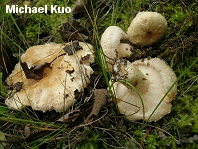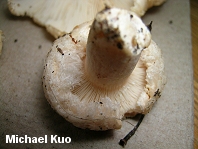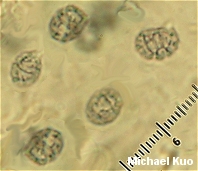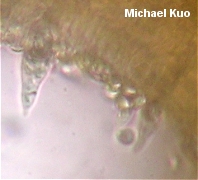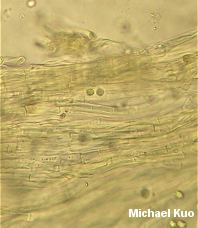| Major Groups > Gilled Mushrooms > Pale-Spored > Lactarius > Lactarius pubescens var. betulae |

|
Lactarius pubescens var. betulae [ Agaricomycetes > Russulales > Russulaceae > Lactarius . . . ] by Michael Kuo This hairy little fellow is a mycorrhizal associate of paper birch across North America, not only where the tree naturally occurs (in boreal and sub-boreal ecosystems; see the map on the linked page) but also where it has been planted as an ornamental. Distinguishing features for Lactarius pubescens var. betulae include its hairy to "bearded" cap margin, its whitish to pinkish colors, and its relatively small spores. The variety described here features milk that turns slowly yellow (or stains tissues or white paper yellow), and widely spaced sporal ornamentation. Lactarius torminosus also associates with birch and is very similar in appearance, but features a more highly colored, orangish pink cap and larger spores. Description: Ecology: Mycorrhizal with paper birch in boreal ecosystems and where the tree has been planted as an ornamental; growing scattered or gregariously; late summer and fall; northern North America. Cap: 3-10 cm across when mature; convex, becoming centrally depressed with an arched margin and, eventually, vase-shaped; whitish to pale pinkish or pale orangish pink; sticky when fresh; covered with a dense layer of appressed hairs; the margin hairy or "bearded," especially when young. Gills: Beginning to run down the stem; close; whitish to pinkish; sometimes stained slowly yellowish by the milk where damaged. Stem: 2-8 cm long; 1-2 cm thick; more or less equal; colored like the cap; dry; bald; without potholes but occasionally with vague brownish spots. Flesh: Whitish to pinkish; sometimes stained slowly yellowish by the milk where damaged. Milk: White; unchanging or changing slowly to yellow or yellowish--or merely drying yellow; staining white paper yellow overnight. Odor and Taste: Odor fragrant and sweet, not distinctive; taste acrid (sometimes slowly). Spore Print: White to cream. Chemical Reactions: KOH negative on cap surface. Microscopic Features: Spores 6-8 x 5-6.5 µ; broadly ellipsoid; ornamentation 0.5-1 µ high, composed of amyloid warts and widely spaced amyloid ridges that sometimes form partial or nearly complete reticula. Pleuromacrocystidia scattered; subclavate to fusoid; to about 60 µ long. Cheilomacrocystidia similar but usually shorter. Pileipellis a cutis of clearly defined, densely packed, cylindric hyphae, sometimes embedded in gelatinous material. REFERENCES: (A. H. Smith, 1960) >Hesler & Smith, 1979. (Methven, 1997; Phillips, 1991/2005; McNeil, 2006.) Herb. Kuo 09039504, 09130801. This site contains no information about the edibility or toxicity of mushrooms. |
© MushroomExpert.Com |
|
Cite this page as: Kuo, M. (2011, February). Lactarius pubescens var. betulae. Retrieved from the MushroomExpert.Com Web site: http://www.mushroomexpert.com/lactarius_pubescens_betulae.html |
